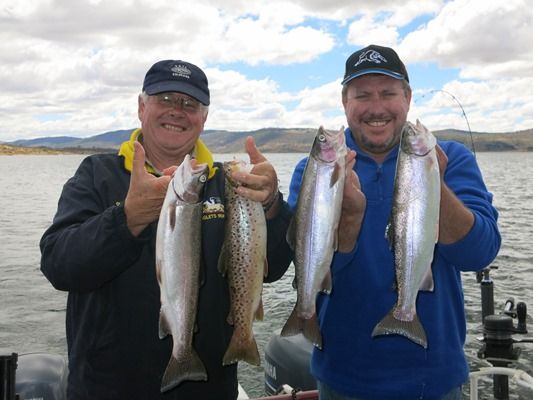Latest News
Snowy trout have not disappeared!
Tuesday, 25 March 2014
A recent Canberra Times Article and a 2XL radio broadcast suggesting ‘Snowy rainbow trout have gone missing’ have created a real stir amongst anglers and the Snowy Tourism Industry. Is it true?
Well it depends who you are or who you talk too: but I wouldn’t blame the Journalists that put out these reports, readers in a hurry can at times focus on the headlines and see what they want to see...missing the details... as John Thistleton Said in the Canberra Times Article ''Fishermen are the worst people for making excuses for themselves.''
More interestingly it can be keen anglers themselves that start these ‘poor fishing’ rumours. Trusty spots, times and techniques that fail due to changing conditions become personal headlines that spread like wildfire...allow me to explain:
Where ever you fish and whatever you fish for it can take just one isolated bad session to start wondering where all the fish have gone…bump into another angler who’s had a bad day and heck it can be like you’re the only two anglers on the lake and all fish have vanished for good! A bad season and the whole sky is falling. But fish don’t just suddenly vanish forever: especially in the snowy lakes; it is after all an ‘impoundment’ not the open sea!
Thankfully most keen anglers are optimistic and patient; have you ever seen an impatient person that gets anywhere with fishing? So after a particularly bad day anglers usually come to their senses, lick their wounds and start over again…and talking is the key…for it only takes hearing of some ones else’s success to realize that either you are doing things the wrong way, or that luck still plays a major role in fishing at times, no matter what skill level you are at.
Even in elite competitions the best anglers have lean days or lean seasons while someone else is cleaning up ‘somewhere and somehow’.
I am in a bit of a lucky position: reports come flooding into my computer and phone regularly so in many instances I can add these to my own experiences and form a ‘statistical approach’ to how the fishing is going. Furthermore I follow up by talking to the most seasoned guides on the lake.
And yes it is true that while the brown trout fishing on Lake Eucumbene has been reasonable, the stocked rainbow trout fishing has been very slow. Eucumbene Authority Col Sinclair blames a 3-4 year boom cycle of good fishing that brought in more anglers and this increased the ‘take’.
Meanwhile stocking levels have remained the same so the ‘put’ hasn’t kept up with the ‘take’. But as anglers disappear due to poor fishing the ‘put’ trout will grow to a nice size and so begins the cycle again, and it takes a stocked fry rainbow 2-5 years to be of the 1-2 pound size people expect to catch. But business are suffering and can’t want years for anglers to return, so Col and other Eucumbene folks are suggesting stocking levels must increase quickly.
The size of the stocked fish will b examined as well: stocked fry have a tiny survival rate of approx 10 percent or less while ‘grown on’ 20 cm fish have an 80 percent survival rate. Fund raisers to grow already allocated fry in private dams or even an Australian Freshwater First-grow out pens on Lake Eucumbene -are touted as a possible solutions. The problem has alleviated a bit in recent weeks as the extreme heat has vanished and Eucumbene rainbow trout that were out deep are returning to the edges in ‘Sort of alright’ numbers. A handful of trollers have done exceptionally well trying new areas.
Over at Jindabyne there were lots of rumours that rainbow stocking was on a downward spiral: not true according to Steve Williamson who explained that; NSW DPI collected the same amount of eggs as ‘usual’ from the Thredbo Spawn Run and stocked the same amount of trout as ‘usual’. And surprise surprise the fishing has been going ‘usual’ as well which for most anglers means a good time catching a few plump rainbows and the occasional brown trout most sessions. The browns have often been chock full of yabby's, while the rainbows have had lots of goldfish in their stomachs at times.
The trick has been to get down deep, trolling at 30 to 40 feet has been as good as ever reports Steve. Surface temps peaked as high as 24 degrees in before the heat waves dissipated, but at the same time were measured at 15 degrees 30 feet down. Weed beds as high as 3 meters have formed in Jindabyne, so sounding these out in the deeper water and dropping a fly or lure into them has also produced good trout. Doing this from the bank has been harder, you can only move around a bit until you find a deep gap in the weed, after which you’re in pole position. And don’t forget to supplement artificial baits with a natural bait like worm or bardi grub, it makes a huge difference.
Problem with us more experienced anglers who can innocently start the ‘where are the fish gone rumours' is that we have fished so much that we have seen some freak seasons and sessions with loads of big fish…so we keep looking for this same high, forgetting that just a few good trout per angler is still a big success. I never take a catch like this for granted (not for long anyway).
Meanwhile newcomers fresh to the whole experience are wrapped with just a trout or two and can’t wait to do more. This is why educating anglers on the basics is such a growth area, in fact the trout dvd from my instructional library collection focused on the essentials in the Snowy Lakes and has been by far my best seller. Many a newcomer writes in each week happy with the trout they have been able to catch, particularly on Lake Jindabyne.
Likewise longest serving and best known Jindabyne guide Steve Williamson has been astonished by the headlines of poor fishing, while in the meantime his Facebook page glows with happy anglers, especially in recent weeks.
Hopefully Eucumbene will get better soon; time will tell.
See you on the water.
Rob Paxevanos
Tags Snowy rainbow



